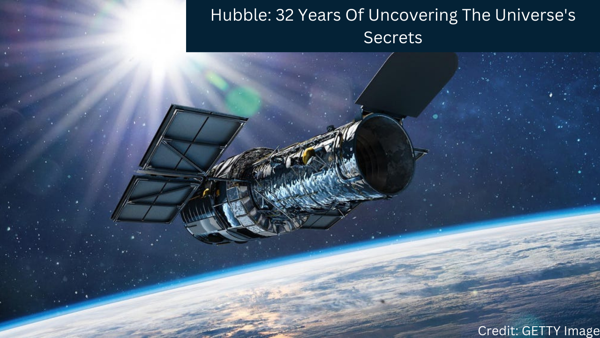
Science & Space
Hubble's Journey From Galaxies to Black Hole: 32 Years Of Uncovering The Universe's Secrets
Hubble, the world's eighth wonder, has been constantly feeding the world with great hidden knowledge of the universe since its launch on April 24, 1990.
The telescope was named after Edwin Hubble, the great astronomer who gave the world Hubble's law, which explained why the universe is expanding and how it is constantly expanding, as well as how cosmological objects are moving away from each other.
The Hubble Space Telescope was not the first space telescope, but it was the first of its kind because it was the largest telescope at the time and the most versatile for conducting widespread research on the universe's hidden agenda.
Hubble was designed to explore the universe with the help of its 2.5 meters mirrors and five other instruments to examine and observe objects in visible, ultraviolet, and near-infrared wavelengths.
Hubble is still observing and photographing unknown worlds despite having completed 2 million observations and studied over 45,000 objects provided by ground telescopes that were unable to explore in detail due to earthly constraints such as variable weather and light pollution.
The concept of a space telescope was first propounded in 1923 but the work on that was never moved because of backwardness in technological breakthroughs and budget constraints.
In 1970, the construction of the Hubble Space Telescope was initiated with the collaboration of the European Space Agency and it was intended to launch in 1983, but the launch was delayed due to technical snags, budget constraints, and the 1986 Challenger space shuttle disaster.
However, it was finally launched in the year 1990. Since its launch, it has captured some spectacular events and it corrected some of the assumptions which were unknown to the world.
Amazing Quest of Hubble to Seek the answer of the Unknown:
Before the launch of the Hubble Space Telescope, the world assumed that the universe was 10 to 20 billion years old. Hubble narrowed the number down to approximately 13.6 billion years after constant observation of stars and other cosmic wonders, a number that is now used to understand the evolution of stars, galaxies, and other objects. Other space telescopes studied the Universe using this age as a baseline, and the most expensive, James Webb, is now examining the age of the universe as well as the early galaxies and stars for further investigation.
Hubble has also discovered supermassive black holes lurking in the centers of galaxies, some of which have been discovered as stray objects moving around the universe without a home. In measuring the Black Hole, Hubble established himself as a true quintessential sky hero. According to the Hubble observation, the mass of a black hole is proportional to the mass of a galaxy's central bulge of stars. More massive the bulge, the more massive the black hole.
Hubble Space Telescope also proves Hubble's law with efficiency and from its observation, a new strangest thing came out of the box that surely the universe is expanding but it is expanding at a much faster rate, driven by the presence of a still-unidentified and previously unknown "dark energy". The correlation between dark energy and dark matter was discovered as a result of this concept, and the relationship was built on observation. Still, the anomaly of dark energy and dark matter persists, and it requires more and more observation with James Webb, the most powerful space telescope ever built.
The Hubble space telescope revealed the truth about our own solar system as well as the solar systems of other galaxies. The telescope has also been used to investigate the formation of the universe, exoplanets, exoplanetary atmospheres, and moons orbiting the solar system's planets. It discovers the moons orbiting Uranus and Pluto, which were previously unknown to the world. We now have a much better understanding of what our solar system looks like and how it works thanks to Hubble.
In 2015, the Hubble Space Telescope examined Kuiper belt objects for the New Horizons fly-by mission, which our ground telescopes were unable to do. It discovered at least five new Kuiper belt objects such as 486958 Arrokoth. On the basis of Hubble's examination, the new Horizon fly past those objects on January 1, 2019.
In 2022, NASA was able to determine the size of the nucleus of comet C/2014 UN271, which is the largest icy comet ever discovered by astronomers.
Hubble was able to predict a supernova with utmost accuracy. On the basis of its data scientists and astronomers calculated the mass of the supernova whose gravity is wrapping the supernova's light.
Scientists and astronomers use the Hubble space telescope to delve deep into the universe's core in search of new knowledge and discoveries, and it paves the way for its successor to examine the universe in greater depth. Because of Hubble's success, scientists and astronomers have and are examining the world with the help of Kepler, Spitzer, and James Webb.

0 Comments